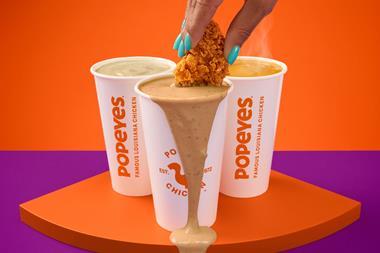The Food and Drink Federation has recently established a group to focus on key issues relating to the nation's health. Obesity cannot be addressed by one organisation alone and we are working with government to meet this challenge.
As chairman of the Federation's GDA steering group, I believe by uniting to introduce front-of-pack GDA labelling, we have started to deliver on our commitment to enhance nutrition information and help government meet pledges made in its Choosing Health White Paper.
Information on the calories, sugars, fat, saturates and salt we should consume for a balanced diet helps consumers make small changes that can make a big difference to lifestyles. We have identified the five components for success: critical mass; consistency; comprehension; credibility and consumer connection.
Twenty-one manufacturers and three retailers representing more than 10,000 lines have agreed to support front-of-pack GDAs - next year nearly 40% of all UK retail food and drink packs will carry such labels. This unites: ABF, AG Barr, Birds Eye, Britvic, Coca-Cola, Cadbury, Calypso, Danone, GSK Healthcare, Kellogg, Kraft, Masterfoods, Morrisons, Nestlé, PepsiCo, Shloer, Somerfield, Sunny Delight, Tate & Lyle, Tesco, Unilever, Vimto and Warburtons.
As for consistency, consumers can now rapidly make two comparisons: they can judge like products side-by-side, or compare them across different categories. So you can compare a prawn sandwich with a BLT, and then a carbonated soft drink with a fruit juice. The adage that you can only compare "apples with apples" is no longer true - now can you compare apples with oranges, or cereals with yoghurts.
A major argument in favour of GDAs is that they are easily understood - they quickly provide per portion information; how much (in grammes) of each of the five key nutrients is in a portion of food; and the percentage of the total GDA of each nutrient in a portion.
GDAs are also based on credible robust science and are finding favour with nutrition experts. They were invented by industry, academia, consumer groups and government in partnership and are based on information published by both a government committee (COMA, now superseded by SACN), and independent academics.
The FDF conducted a survey of 45 professional, independent nutrition consultants. The majority credit both Multiple Traffic Light (MTL) and GDAs as being equally good ways to give consumers "at a glance" information on nutrient levels. But 80% think GDA labels help consumers see the contribution a product makes to their diet compared with just over 10% for MTL labels, and 75% think the GDA scheme is a scientifically valid form of providing information on labels about the nutritional content of a food portion in relation to an average adult's approximate daily requirements (compared with less than 50% for MTLs).
GDAs don't demonise categories of products and also recognise portion size is key to making healthy decisions. Next year an integrated marketing campaign is launched to explain GDAs. The first phase is online at www.whatsinsideguide.com. We believe they are already having a positive impact on consumer decision-making. Tesco noticed a change in consumer buying when GDA labels were added to ready meals - lower-fat alternatives outsold higher fat varieties by 7%, while lower salt meals outsold higher salt versions by 10%.
As chairman of the Federation's GDA steering group, I believe by uniting to introduce front-of-pack GDA labelling, we have started to deliver on our commitment to enhance nutrition information and help government meet pledges made in its Choosing Health White Paper.
Information on the calories, sugars, fat, saturates and salt we should consume for a balanced diet helps consumers make small changes that can make a big difference to lifestyles. We have identified the five components for success: critical mass; consistency; comprehension; credibility and consumer connection.
Twenty-one manufacturers and three retailers representing more than 10,000 lines have agreed to support front-of-pack GDAs - next year nearly 40% of all UK retail food and drink packs will carry such labels. This unites: ABF, AG Barr, Birds Eye, Britvic, Coca-Cola, Cadbury, Calypso, Danone, GSK Healthcare, Kellogg, Kraft, Masterfoods, Morrisons, Nestlé, PepsiCo, Shloer, Somerfield, Sunny Delight, Tate & Lyle, Tesco, Unilever, Vimto and Warburtons.
As for consistency, consumers can now rapidly make two comparisons: they can judge like products side-by-side, or compare them across different categories. So you can compare a prawn sandwich with a BLT, and then a carbonated soft drink with a fruit juice. The adage that you can only compare "apples with apples" is no longer true - now can you compare apples with oranges, or cereals with yoghurts.
A major argument in favour of GDAs is that they are easily understood - they quickly provide per portion information; how much (in grammes) of each of the five key nutrients is in a portion of food; and the percentage of the total GDA of each nutrient in a portion.
GDAs are also based on credible robust science and are finding favour with nutrition experts. They were invented by industry, academia, consumer groups and government in partnership and are based on information published by both a government committee (COMA, now superseded by SACN), and independent academics.
The FDF conducted a survey of 45 professional, independent nutrition consultants. The majority credit both Multiple Traffic Light (MTL) and GDAs as being equally good ways to give consumers "at a glance" information on nutrient levels. But 80% think GDA labels help consumers see the contribution a product makes to their diet compared with just over 10% for MTL labels, and 75% think the GDA scheme is a scientifically valid form of providing information on labels about the nutritional content of a food portion in relation to an average adult's approximate daily requirements (compared with less than 50% for MTLs).
GDAs don't demonise categories of products and also recognise portion size is key to making healthy decisions. Next year an integrated marketing campaign is launched to explain GDAs. The first phase is online at www.whatsinsideguide.com. We believe they are already having a positive impact on consumer decision-making. Tesco noticed a change in consumer buying when GDA labels were added to ready meals - lower-fat alternatives outsold higher fat varieties by 7%, while lower salt meals outsold higher salt versions by 10%.














No comments yet